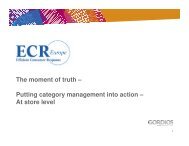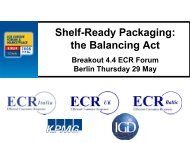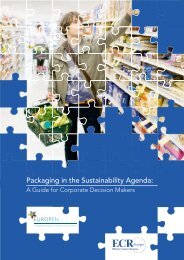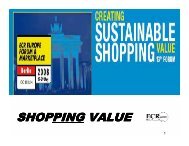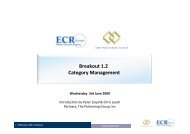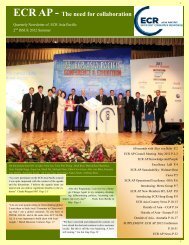You also want an ePaper? Increase the reach of your titles
YUMPU automatically turns print PDFs into web optimized ePapers that Google loves.
Replenishment<br />
Return of a shipment to the party who originally<br />
delivered it to the carrier.<br />
Replenishment system<br />
The act of providing customers with fresh quantities of<br />
a product.The way in which delivery to customers<br />
takes place. (e.g. delivery in response to supply orders:<br />
ordering system. The delivery is on the basis of the<br />
sales, stocks, stock standards, stock locations and lead<br />
times of the customers: CRP)<br />
Retail Distribution Centre (RDC)<br />
A consolidation warehouse in the retail part of the<br />
supply chain, where product flows from manufacturers<br />
are received and where load disassembly, storage and<br />
reassembly can take place prior to shipment to store.<br />
Reuse (94/62/EC)<br />
Reuse shall mean any operation by which packaging,<br />
which has been conceived and designed to accomplish<br />
within its life cycle a minimum number of trips or<br />
rotations, is refilled or used for the same purpose for<br />
which it was conceived, with or without the support of<br />
auxiliary products present on the market enabling the<br />
packaging to be refilled; such reused packaging will<br />
become packaging waste when no longer subject<br />
to reuse.<br />
Roll cage sequencing<br />
Store-layout oriented picking into roll cages in a retail<br />
warehouse.<br />
Safety stock<br />
The stock which serves to offset differences between<br />
forecast consumption and actual consumption and<br />
between expected and actual delivery times. In<br />
calculating the safety stock, account is taken of such<br />
factors as service level, expected fluctuations of<br />
demand and lead time.<br />
Secondary Packaging (94/62/EC)<br />
Packaging conceived so as to constitute at the point of<br />
purchase a grouping of a certain number of sales units<br />
whether the latter is sold as such to the final user or<br />
consumer or whether it serves only as a means to<br />
replenish the shelves at the point of sale; it can be<br />
removed from the product without affecting its<br />
characteristics.<br />
Shelf replenishment<br />
The activities involved in placing secondary or primary<br />
items on display and their movement to the display<br />
area.<br />
Stockkeeping Unit (SKU)<br />
1. In Europe an SKU is a uniquely identifiable product<br />
available for sale at a specific point in time.<br />
2. An item in a particular geographic location. For<br />
example, one product stocked at six different<br />
distribution centres would represent six SKU’s (US).<br />
Supply chain<br />
All business activities needed to satisfy the demand for<br />
products or services from the initial requirement for<br />
raw material or data to final delivery to the end user.<br />
System (ISO 3676)<br />
An entity consisting of interdependent components.<br />
Tertiary Packaging (94/62/EC)<br />
Packaging conceived so as to facilitate handling and<br />
transport of a number of sales units or grouped<br />
packagings in order to prevent physical handling and<br />
transport damage. Transport packaging does not<br />
include road, rail, ship and air containers.<br />
UCC/EAN-128 (also known as UCC-128)<br />
Bar code symbols and data formats used for primary<br />
and secondary product identification. Primary<br />
identification consists of two formats: the serial<br />
Shipping Container Code and the UPC Shipping<br />
Container Code. The Serial Shipping Container Code is<br />
an 18-digit code for the unique identification of<br />
individual mixed merchandise shipping container,<br />
typically used in conjunction with an EDI Advance<br />
Shipping Notice transaction. The UPC Shipping<br />
Container Code is a 1-digit code used to identify a<br />
standard pack or standard case.<br />
Unit Load (ISO 3676)<br />
A load consisting of items or packages held together<br />
by one or more means, and shaped or fitted for<br />
handling, transporting, stacking and storing as a unit.<br />
The term is also used to describe a single large item<br />
suitable for the same purpose.<br />
Value Chain Analysis (VCA)<br />
A financial tool for identifying and quantifying costreduction<br />
opportunities within the supply chain.<br />
Vehicle Optimisation<br />
Method to optimise loading and utilisation of<br />
transportation vehicles.<br />
Figure 40: Packaging levels<br />
Three packaging levels<br />
Primary Secondary Tertiary<br />
Source: A.T. Kearney, Efficient Unit Loads project<br />
The Efficient Unit Loads Report 69



